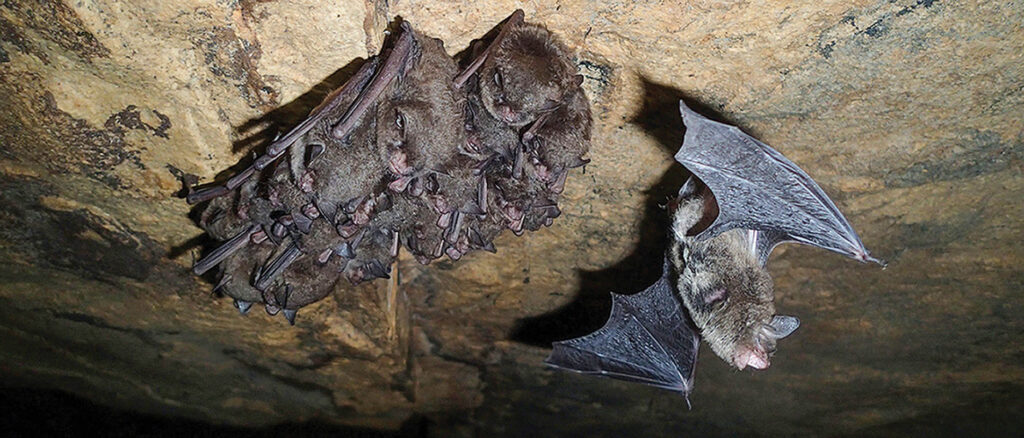
In a wooded area at Warbler Ridge, a few brave souls sit still and silent, enduring the sweltering mid-summer heat and hungry mosquitos. No campfire glows or flashlight shines as they face into the setting sun and wait for bats, nocturnal flying mammals.
The location was determined by researchers from the Illinois Bat Conservation Program (IBCP), who arrived at Warbler Ridge during summer 2018, ready to conduct a formal bat census. They utilized two forms of technology which allow “seeing into the dark” – acoustic monitoring and radio telemetry. The researchers were invited by the Grand Prairie Friends, a volunteer-focused not-for-profit organization dedicated to natural areas restoration in Illinois.
Acoustic monitors detect and record bats’ vocalizations (inaudible to the human ear). Computer analysis converts each audio file into a spectrogram, which is indicative of a bat’s species.
In the dark sky above, a few bats swoop and soar. They voice their ultrasonic calls and listen as sound bounces off tasty flying insects, corn-borer moths, mosquitos, etc.
To initiate radio telemetry, the researchers set up mist netting (rectangular nets comprised of fine threads, difficult for the bats to detect by sight and echolocation). A researcher gently examines a detained bat to determine its age, weight, health, etc. If it is a female, a rounded belly suggests pregnancy or lactating mammary glands indicates motherhood.
A tiny radio transmitter is glued onto its back, and off it goes wearing its “backpack” emitting radio pulses. When a receiving antenna picks up a radio pulse, a researcher tracks the bat to where it slept during the day, thereby discovering a roosting site or the “bats’ maternity ward.”
“Nine of the 13 bat species living in Illinois are known to reside in the area. At Warbler Ridge, we discovered big brown, eastern red, and evening bats. At a nearby state park, the federally endangered Indiana bat was captured and radio-tracked to roost trees, procedures which are a top conservation priority for these species ,” said Tara Hohoff, IBCP project coordinator.
The researchers’ findings set in motion something amazing at Warbler Ridge Conservation Area. The area encompasses 1,000 acres along the Embarras River corridor in Coles County and is owned and managed by Grand Prairie Friends, a not-for-profit organization. Apex Clean Energy offered to partner with the organization on a 165-acre habitat enhancement project, extending over a 30-year period. Several thousand native hardwood trees and wildflowers were planted, and wetlands were constructed. For the bats, 22-foot tall artificial bat habitat structures, called bat pods, were installed.
“In the future, we hope to see bats emerging from the newly erected bat pods,” commented Terry Smith, a volunteer and member of Grand Prairie Friends. “We are waiting for that aha moment when we can see indications of success in producing a good habitat.”
“Volunteers may have begun the summer with a degree of respect for bats but soon develop such enthusiasm they feel the need to share their knowledge and sense of awe with others,” commented Grand Prairie Friends’ Director Sarah Livesay. “Their advocacy on behalf of bats goes a long way in helping create an environmentally-informed citizenry.”
Bat populations across North America are declining due to changes in land use, disturbances to bat hibernacula, exposure to white-nose syndrome (a fatal fungal disease) and other factors. Citizens are taking action in the hope that a diverse species of bats will exist in the future.
For more information go to illinoisbats.org and grandprairiefriends.org.









